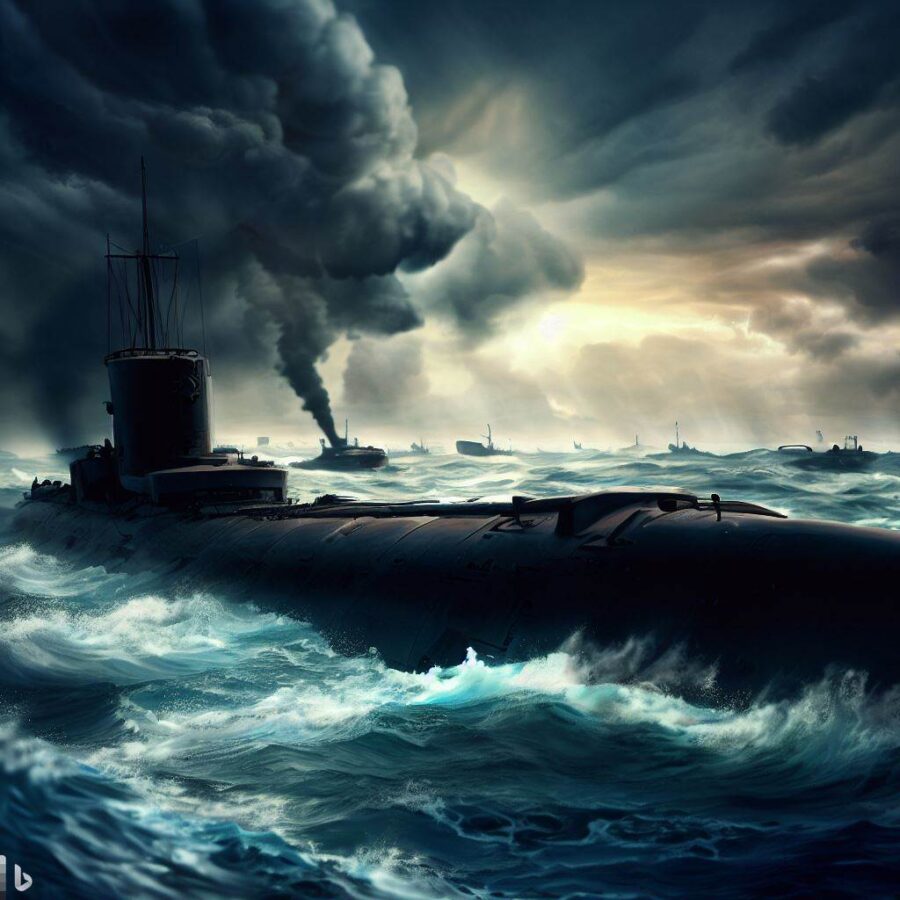The Battle of the Atlantic, a pivotal naval campaign that raged throughout World War II, stands as a testament to the unyielding resolve of both Allied and Axis forces. This protracted conflict was defined by the relentless attacks of German U-boats, known as “wolf packs,” against vulnerable Allied convoys. In this comprehensive exploration, we will delve deeply into the chilling assaults orchestrated by the U-boats, the extensive damages inflicted upon merchant ships, the strategic shifts that ultimately reversed the tide in favor of the Allies, the staggering losses of ships and lives, and the enduring impact of this historic maritime struggle.
The U-Boat Threat: Unleashing the “Wolf Packs”
German U-boats, revolutionary submarines armed with torpedoes, unleashed havoc upon Allied convoys using a tactic known as the “wolf pack.” This strategic approach involved the coordinated attack of several U-boats on a single convoy, employing a combination of torpedoes and surface artillery. The element of surprise was crucial, as these wolf packs struck swiftly and then disappeared beneath the waves, leaving chaos and destruction in their wake. The strategic use of wolf packs allowed the German Navy to exert control over the Atlantic, endangering the flow of vital supplies and reinforcements to the Allied forces.
Devastating Damages: Merchant Ships Under Siege
The U-boat attacks inflicted significant damage upon the merchant ships that formed the backbone of Allied supply lines. These ships were lifelines, transporting essential supplies, equipment, and troops across the vast expanse of the Atlantic. However, the U-boats’ ruthless attacks resulted in the sinking of thousands of ships, leading to critical shortages of resources. The toll was not only material but also psychological, as the Allies grappled with the realization that their lifelines were under constant threat.
The Battle of Wits: The Allied Response
To counter the U-boat threat, the Allies embarked on a series of strategic and technological shifts that would prove pivotal in turning the tide of the battle. Improved convoy tactics, advanced sonar technology, and the deployment of long-range aircraft for aerial reconnaissance and attack all contributed to the gradual erosion of the U-boats’ advantage. The development of sophisticated anti-submarine warfare techniques enabled the Allied forces to locate and eliminate U-boats with greater efficiency. This combination of strategies marked a turning point in the battle, shifting momentum in favor of the Allies.
Human and Material Losses: Counting the Cost
The Battle of the Atlantic exacted a heavy toll on both sides, leaving an indelible mark on the war’s history. Thousands of lives were lost due to U-boat attacks, unforgiving weather conditions, and the inherent dangers of naval warfare. The civilian and military personnel aboard the merchant ships and naval vessels faced tremendous peril as they navigated the treacherous waters of the Atlantic. The material losses were equally staggering, with the sinking of numerous ships resulting in a severe blow to the Allied logistical efforts.
The Turning of the Tide and Final Victory
The turning point of the Battle of the Atlantic arrived in 1943 when the cumulative efforts of the Allies began to yield tangible results. Their innovative tactics, technological advancements, and unyielding determination began to outmaneuver the U-boats. The U-boats’ success rate dwindled, eroding their morale and forcing them into retreat. By 1945, the Allies had successfully secured their control over the Atlantic, a victory that paved the way for the success of subsequent military operations.
The Battle of the Atlantic, characterized by the menacing shadow of U-boat “wolf packs,” remains an emblem of human perseverance in the face of relentless adversity. The U-boats’ unrelenting assaults tested the resolve of the Allied forces, pushing them to innovate and adapt. Through their strategic shifts and the sacrifices made, the Allies managed to turn the tide of this crucial naval battle. The memory of the staggering human and material losses suffered during this period serves as a poignant reminder of the sacrifices made for a greater cause. Ultimately, the Battle of the Atlantic underscores the triumph of unity, innovation, and the unwavering human spirit in times of crisis…

Originally posted 2023-08-14 07:43:13.




